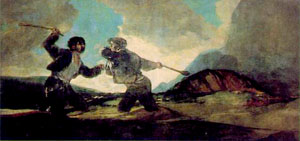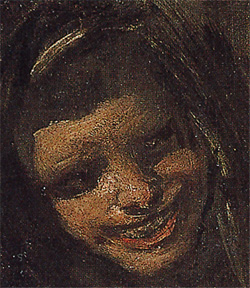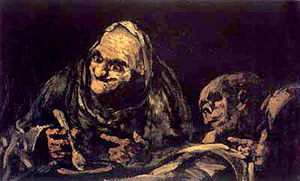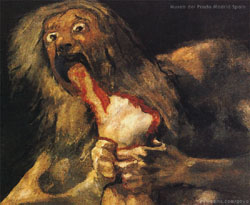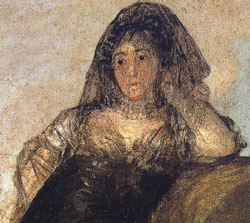The Black Paintings
Using the al secco painting technique, Goya used oils to paint directly onto the plaster walls of his home, called La Quinta del Sordo, making the 14 paintings that have come to be known as a single group called The Black Paintings. He created the images between 1820 and 1824, when he would have been 74 years old. "Goya's
growing political, intellectual, and human isolation may
well have led him to decide to paint for no one but himself.
The Black Paintings... are in effect the most extreme manifestation
of the growing misunderstanding and estrangement between
modern society and the artist. It is true that many subsequent
artists painted or drew or carved works of art that they
intended to be enjoyed and understood by only themselves.
But never before and never since, as far as we know, has
a major, ambitious cycle of paintings been painted with
the intention of keeping the pictures an entirely private
affair. The very fact that Goya had recourse to fresco painting
instead of the more usual canvas and oil is proof enough
that he never expected his paintings to be displayed in
public, and since very few people made their way out to
visit Goya's retreat, these paintings are as close to being
hermetically private as any that have ever been produced
in the history of Western art." "The
most celebrated pictures of Goya's last years are the series
of 14 so-called "Black Paintings" done for a suite
of rooms in the coutry house just outside Madrid that he
purchased in 1819. Aged 74 when he began this group, he
had already been dangerously ill in 1819, as the Self-Portrait
with Doctor Arreita, a gift of gratitude to his doctor,
records. Old age and infirmity have been suggested as a
linking theme for this series. But the overall meaning has
never been satisfactorily explained. All the pictures were
painted directly onto the wall and they are all, to a greater
or lesser degree, damaged. In 1878 they were transferred
to canvas supports. Goya painted these works very rapidly,
using broad strokes applied with large brush, palette knife
and possibly sponges. He may have regarded them primarily
as a technical experiment. Attempts to tease out connections
with the earlier Caprichos or Disastros have
proved difficult. They are perhaps best considered as hermetic
self-contained fantasies, despite several elements being
based upon, or strongly evocative of, earlier images. Suggestions
that they contain an essentially nihilistic message are
not convincing. If any connection can be made to earlier
work it is with the "Proverbios," or "Disparates,"
a short series of 22 prints made by Goya between 1816 and
1823 but unpublished until 1864."
|
| Goya's the "Black Paintings" Atropos (The Fates) Goat Fight with Cudgels Two Women Men Reading Old Men Asmodea Old Men Eating Saturn La Leocadia |
Writings about the Black Paintings The Black Paintings De Salas on the Black Paintings Lubow on the Black Paintings |
- - - - - - - - - - - - - - - - -
- - - - - - - - - - - - - - - - -
WEB SITE COPYRIGHT©1997-2006 ERIK E. WEEMS
IMAGES ARE COPYRIGHT TO THEIR RESPECTIVE OWNERS
http://www.eeweems.com/goya/black_paintings.html
BIO | ARTWORK | BOOKS | RESOURCES FOR STUDENTS | LINKS | CONTACT | NEWS | STATS | F.A.Q.




